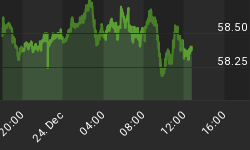Dr. Martin Murenbeeld, chief economist for Dundee Wealth Economics and one of the smartest gold minds around, recently released his latest chart book - hundreds of useful visuals to help him tell the gold and commodity stories.
Dr. Murenbeeld also outlines his nine bullish arguments for gold.
-
Global fiscal and monetary reflation - The world's major economies have taken on extensive amounts of debt to keep their economies afloat. The struggles of Greece and other nations in Western Europe haven't gone away. The U.S. has spent hundreds of billions of dollars in stimulus money and is still losing jobs.
-
Global imbalances - The dollar has benefited from the troubles in other countries in its role as a relative safe haven. "Relative" is the key word - roughly $10 trillion is expected to be added to the U.S. federal debt burden through 2019 and the U.S. trade imbalances are huge. These trends stand to weigh on the dollar and support gold's safe haven status over the longer term.
-
Global foreign exchange reserves are "excessive" - Global foreign exchange reserves have expanded exponentially in just the past few years, reaching $8.17 trillion in April 2010. Meanwhile, the gold reserve ratio has dropped significantly since 1980.
-
Central bank attitudes to gold - Under the current central bank selling agreement, only the International Monetary Fund has been a seller of gold. Latin American countries, who were net sellers of gold up until 2002, are now buying gold again. India purchased 200 metric tons from the IMF in the fourth quarter of 2009, setting a floor under gold just above $1,000. China has increased its gold reserves from 395 metric tons in 2001 to 1,054 metric tons as of the end of the first quarter -- a 166 percent increase in less than a decade.
-
Gold is not in a bubble - Gold's run has been slow and steady. As I mentioned last week, we're not seeing large price spikes that are typical with bubbles. The chart below illustrates just how different gold's current bull run has been from previous ones. A key difference today is that we're seeing greater affluence in the developing world, where people have traditionally turned to gold to store their wealth.

-
Mine supply is flat - World mine production is about 2,500 metric tons -- roughly 25 percent higher than it was in 1990 -- but net mine supply is less than it was 20 years ago. Dehedging, increased scrap supply, lower grade discoveries and higher replacement costs will continue to constrain supply. We're already seeing this affect the marketplace. During the second quarter of 2010, gold demand rose 36 percent year over year, while supply was up just 17 percent.
-
Investment demand - Investment demand in the second quarter of 2010 more than doubled compared to the same period in 2009, and accounted for more than half of total global demand. Investors bought the most gold since the first quarter of 2009, at the depths of the Great Recession.
-
Commodity price cycle - Commodity price cycles tend to last multiple decades. Going back to 1800, the shortest gold cycle is 10 years and shortest copper cycle is 14 years. The current bull cycle began in 2001.

-
Geopolitical environment - Historically, gold has performed well in times of political and financial turmoil. Gold hit an all-time high (inflation adjusted) in 1980 amid the Iran hostage crisis and the Soviet invasion of Afghanistan. Today's geopolitical climate is also volatile given the ongoing wars in Iraq and Afghanistan and the pursuit of nuclear arms by Iran and North Korea.
With these nine factors, Dr. Murenbeeld makes a strong bullish case for gold and others seem to agree. A Bloomberg survey of 29 analysts last week reported that they see gold prices averaging $1,500 in 2011 -- a 20 percent jump from current levels.
To read more of Frank's insights on gold, visit the gold section of his investment blog, Frank Talk at www.usfunds.com/franktalk. Also visit www.usfunds.com for interesting research, quizzes and even games on commodities and emerging markets.
All opinions expressed and data provided are subject to change without notice. Some of these opinions may not be appropriate to every investor.
















